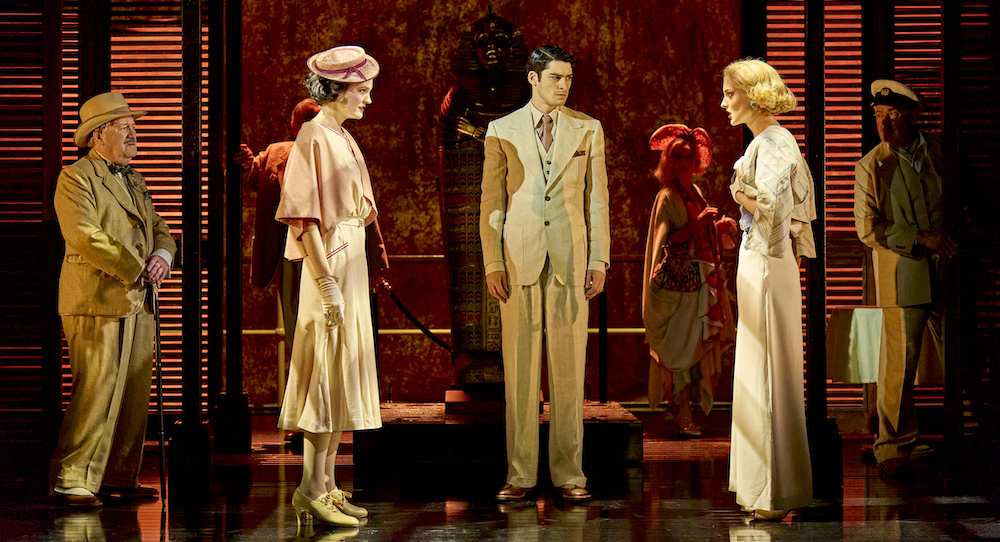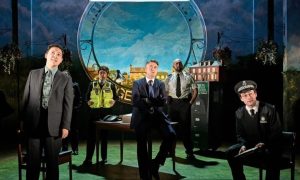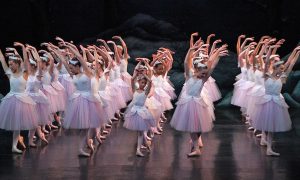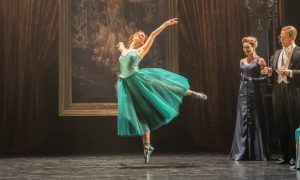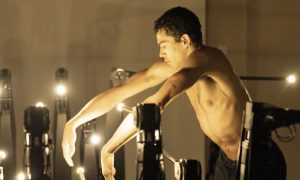Richmond Theatre, London.
9 October 2025.
Death on the Nile, adapted for the stage by Ken Ludwig, is an extremely well-staged and engaging production from start to finish. Published as a novel in 1937, Death on the Nile is effectively a love story mixed with jealousy and rivalry, underpinned by greed that meets a nasty end!
One of the most impressive parts of this theatrical adaptation of one of Agatha Christie’s classics was the two-tiered staging, designed by Mike Britton, and the actors use of it, organized by movement director Liam Steel.
Huge dark wooden plantation shutters stretched across the width and visible height of the stage and sectioned off different areas across two floors of the cruise ship. Railings ran across the front of the shutters, and many mini-scenes took place ‘outdoors’ on both decks with characters leaning on them looking out ‘to sea’ and even overhearing conversations on the deck above or below them. Especially Poirot, who was often seen smoking in the shadows and observing or listening to interactions. Excellently designed, enabling the audience to witness all the action even in different parts of the boat.
Shutters slid back and forth to highlight the different spaces and scenes, and lighting design by Oliver Fenwick also added great ambience. Warm orange and yellow back lighting seeped through the shutters for morning scenes on the Nile, and shadowy ripples on the shutters created a convincing water effect. Bird and insect sound effects, as well as Egyptian background music, all contributed to an atmospheric and believable setting.
As each character was introduced, with their own intriguing subplots, there were some fabulously ambiguous and eerie moments, where you sensed something was up, but were not quite sure what! There was a cast of excellent team players who mostly supported each other on stage: Esme Hough played Jacqueline de Belfort – Jacqui – the girlfriend of Simon Doyle. Her presentation of this erratic and unpredictable character was very effective in creating an unsettling feeling; and Mark Hadfield, playing Hercule Poirot himself, grew throughout the play with a satisfyingly recognisable portrayal of the infamous man.
A substantial jolt of the boat mid-cruise led to a pivotal moment raising suspicions – of whom or what, was not yet known – but passengers lurched, and Linnet who had been egotistically messing around stepping inside the Egyptian vertical coffin (that made a striking centre piece on stage) became trapped inside. Who pushed the coffin door shut, and who pushed them to make them do it became a temporary fiery focus, delightfully concocted to have the audience speculating before any murder had even taken place.
There was a dramatic scuffle as they all worked to prise the coffin open to rescue Linnet, damaging it in the process, to the great distress of Egyptologist Atticus Praed, played by Howard Gossington, who had the artefact in his care. As the storyline progressed, Poirot continually stressed the universally important theme of turning from evil and not giving up on love.
The anticipated murder took place and faces of all the suspects loomed in and out of the spotlight from behind the shutters, bringing a spooky climax to the end of Act 1 and allowing time for discussion and deliberation over the interval.
“I believe everyone on this boat is a suspect until proven innocent,” Poirot said calmly at the start of the second act and scrutinized each passenger in turn with his piercingly perceptive insights. Murder motives for each and every one of them there emerged. Captivating staging again here; the action moving swiftly from cabin to cabin as the interviews took place. Shutters were slid across and a different cabin lit each time, along with slick furniture or prop movement by the ensemble team.
Even in this serious moment, there was humour. One of the passengers gave a tongue-in-cheek side-note to the audience, stating that they hated the part where all the suspects are gathered and Poirot reveals the murderer. Poirot gave a knowing smile and said animatedly, “I love this part!”
The passengers gathered around Poirot as he pieced together the evidence. He walked and talked us through his thought process, and effective snippets of relevant flashbacks were staged under blue light. The actors were all extremely absorbing and believable in their roles, with well-thought out and relevant body language.
One of you is lying, Poirot said, as it appeared that everyone there had an alibi, and there were gasps in the audience as the final scene revealed itself.
“It was a memorable trip.” Poirot raised his eyebrows wryly reflecting on the culmination of events. And the play ended as it had begun: Simon and Jacqui, the two lovers, embraced stage right, with Linnet in golden sparkling evening gown, looking down on them from top the deck. A dramatic but satisfying end to a great evening out.
By Louise Ryrie of Dance Informa.


